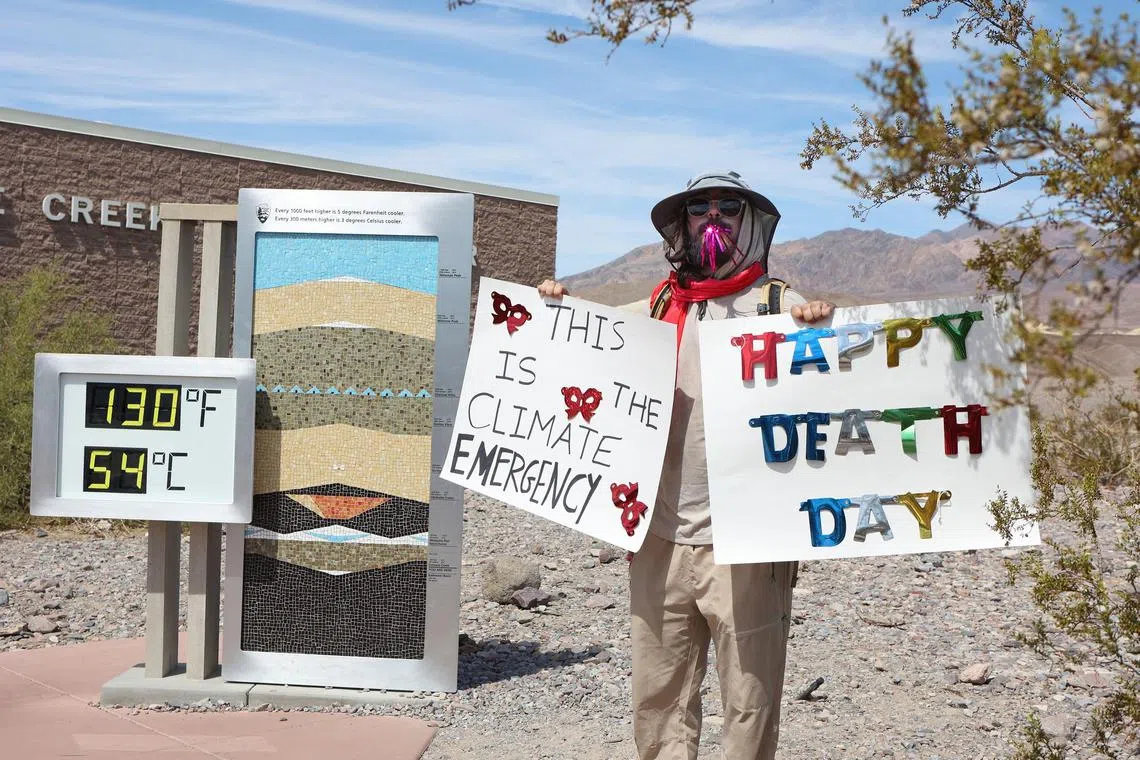2023 on track to be the hottest year ever recorded
Sign up now: Get ST's newsletters delivered to your inbox

A protester stands next to a digital display of an unofficial heat reading in Death Valley, California, on July 16.
PHOTO: AFP
Follow topic:
WASHINGTON – The hottest June on record 10 of the hottest days in history.
Simultaneous heatwaves are suffocating the United States, much of Europe and parts of Asia, while El Nino intensifies in the Pacific Ocean, and the Atlantic waters off Florida hit an unprecedented 32.2 deg C.
It is already enough to put 2023 on a likely trajectory to become the warmest year since record-keeping began in the 1800s.
Since October 2019, the research non-profit Berkeley Earth has been analysing each month’s global temperatures and issuing predictions for the year’s ultimate rank in terms of heat. Its latest analysis, published on July 11, found “a fairly high chance – above 80 per cent at this point – that 2023 will be the warmest year on record”, said Dr Zeke Hausfather, a Berkeley Earth climate scientist.
Researchers will finalise annual temperature rankings in January. To date, the hottest year on record is a tie between 2016 and 2020.
For long-time climate observers, the summer’s breakneck pace of temperature records is a grim pattern long predicted, and one with little chance of breaking.
“I’ve been expecting this for 20 years,” said Professor Camille Parmesan of the National Centre for Scientific Research and an Intergovernmental Panel on Climate Change (IPCC) report author. “This is just going to keep happening, given that we’re not reducing emissions.”
Earth has already warmed 1.2 deg C since the pre-industrial era due to growing greenhouse gas emissions in the atmosphere. This has resulted in a clear trend: 22 of the last 23 years were the hottest ever.
The only way to stop this trend, climate scientists have repeatedly warned, is for people to dramatically and immediately cut their climate pollutants, mainly through ditching fossil fuels.
The El Nino factor
High among the factors pushing this year’s unparalleled heat trajectory is the aforementioned El Nino, the first in nearly four years.
The Pacific basin covers a third of the planet and is subject to the El Nino-Southern Oscillation, which ping-pongs the ocean’s temperatures between cold and warm phases. 2023 started off in the La Nina phase, officially switching to El Nino in June.
“Every time we have an El Nino event, we get a small peek into the future. This is what is going to be the new normal for the climate in five to 10 years if our emissions keep at current levels and don’t decrease rapidly,” Dr Hausfather said.
“So we’re going to have slightly higher than normal temperatures this year and next, but long-term climate change is going to quickly push the planet to these levels of heat all the time,” he added.
Worsening climate change is driving up the frequency and intensity of extreme weather events, and this summer is no exception.
Heatwaves have plagued Japan, India and the US, which has also struggled with devastating flooding in the North-east. Drought now grips Europe, following record spring heat in the Mediterranean. Canada is wrestling with out of control wildfires, which have unleashed waves of dangerous smoke on millions of people across North America.
El Ninos are just another type of extreme event that have also grown stronger in recent decades due to climate change.
“Since 1950, El Ninos have been significantly stronger than any time from 1400 to 1950,” Prof Parmesan said, citing a 2021 IPCC report she helped write.
Brown University climate scientist Kim Cobb said: “We haven’t had an El Nino event at this level of global warming. Maybe that’s an obvious statement, but I think it still needs to be said.”
‘A lot of bad stuff’
The implication is we do not really know what is in store, Dr Cobb warned, adding that El Nino is only just beginning, “and it’s forecast to get quite a bit stronger”.
Berkeley Earth’s estimated odds for 2023 as the hottest year increased as the year went on; if the El Nino persists and intensifies, 2024 could be hotter.
After January, the group noted that 2023 had a 14 per cent chance of being the hottest year; by the end of May, it had risen to 54 per cent. Then came a stunningly hot June. Declared the warmest on record by Berkeley Earth, the US National Centres for Environmental Information and the European Union’s Copernicus Climate Change Service, it beat out by a significant margin a previous set in 2022.
Even more disasters are expected to plague communities as the year continues, amid an especially hot summer and fall. Or, as Dr Hausfather put it: “A lot of bad stuff.” BLOOMBERG

